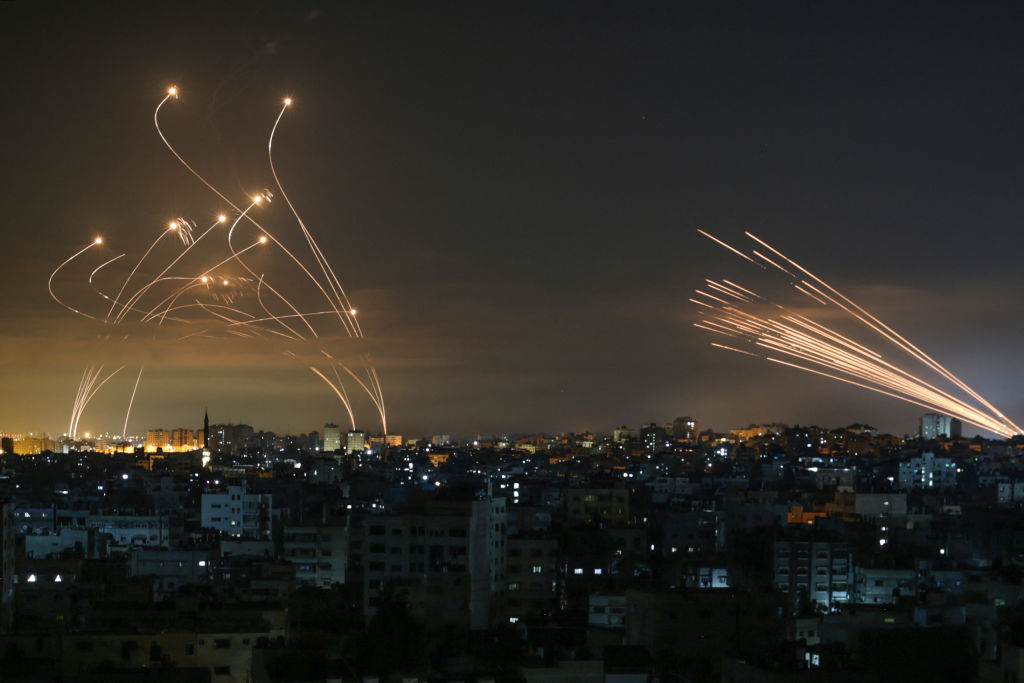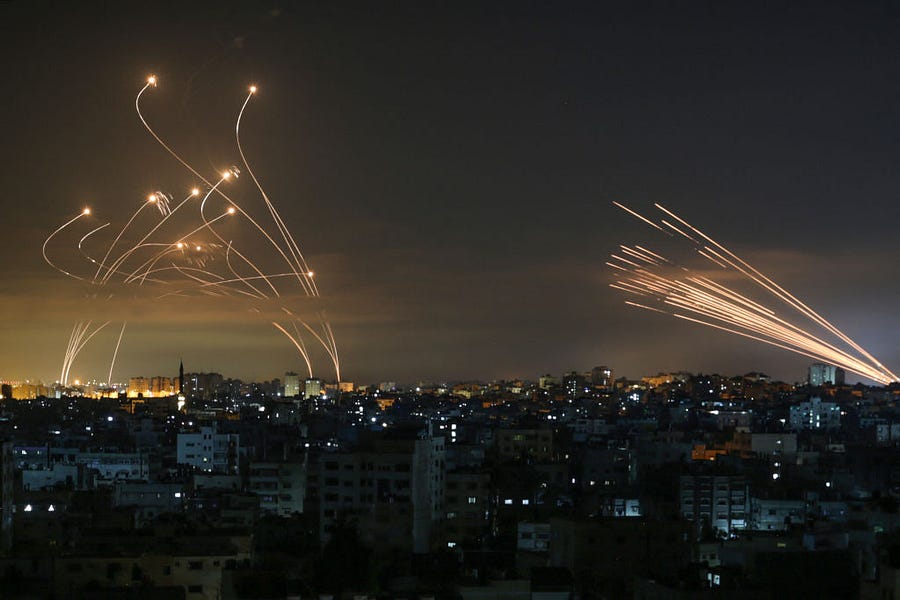The Iron Dome isn’t Israel’s only line of defense against incoming projectiles, but it’s certainly its most famous. When a torrent of unguided rocket fire rained down on the Jewish state during its 11-day conflict with Hamas earlier this year, the system detected and destroyed about 90 percent of the thousands of explosives destined for populated areas in Israel, sparing the lives of civilians beneath with minimal but deadly breakthrough.
For weeks during and after the war, a viral image of the Iron Dome in action occupied a near-constant place in the global news cycle. On the right, a deluge of indiscriminate artillery fire from the Gaza Strip is seen approaching Israel’s urban centers. On the left, interceptors maneuver to meet and neutralize the incoming rockets midair.

Israel’s short-range air defense system made headlines once again in recent weeks, when infighting among House Democrats brought U.S. funding for the Iron Dome to the forefront.
After the Democratic Caucus’ progressive wing pulled $1 billion designated for replacement interceptors from a government funding bill in September, Democratic leadership moved to push through a standalone bill to secure the funds separately. The ensuing vote culminated in denunciations of Israel as an “apartheid state,” counter-accusations of anti-Semitism by the Caucus’ Jewish members, and a tearful “present” vote by New York Rep. Alexandria Ocasio-Cortez.
After the standalone measure passed the House 420-9, it faced additional challenges in the Senate. Libertarian-leaning Republican Sen. Rand Paul promptly shot down a unanimous consent resolution to expedite a floor vote on the bill, proposing instead to draw the cash from $6 billion in reconstruction funds for Afghanistan.
“It’s a shame that Senator Paul uses a fig leaf to try to suggest that eliminating funding for critical elements of our Afghanistan involvement is the reason to hold up Iron Dome funding. He just doesn’t like Iron Dome, no matter what he says,” Democratic Sen. Bob Menendez, chairman of the Senate Foreign Relations Committee and originator of the resolution to fast-track funding, told The Dispatch. “Having said that, I’m convinced that Iron Dome will get done. The only question is for the leader to decide whether or not we will have a standalone vote in the Senate or it will be wrapped up into [National Defense Authorization Act].”
Asked if he supports $1 billion to replenish Iron Dome, Sen. Chris Coons—another leading committee member—said “absolutely,” and that the measure’s passage “should have already happened.”
Paul, meanwhile, punted blame for the bill’s delay to Senate Democrats for rejecting his bid to divert funding. “I have a proposal to fully fund it with money from the Afghan Reconstruction Fund, which could potentially go to the Taliban,” he told The Dispatch. “It could be passed already, but the Democrats blocked that yesterday.”
“Ultimately, for me, where the funds come from is less important than actually doing it,” Sen. Marco Rubio, a Florida Republican, told The Dispatch. “I think they need to be resupplied.”
Despite overwhelming bipartisan support for Israel’s right to self defense, recent finger-pointing in both chambers has drawn renewed national attention—and scrutiny—to the function and value of cooperative missile defense with our foremost Middle Eastern ally. Why is it a component of our regional engagement? Is it just a goodwill project?
The Iron Dome was created by Rafael Advanced Defense Systems Ltd.—an Israeli-owned defense company—to respond to a specific, short-range projectile threat emanating from adversaries in surrounding countries and Palestinian territories, filling a gap that became painfully apparent after a 2006 war with Lebanese Hezbollah resulted in 44 Israeli civilian deaths. The interceptors work alongside David’s Sling, which intercepts mid-range missiles, and Arrow 3, an anti-ballistic missile system, to deter attacks and limit civilian casualties in the event that deterrence fails.
In April 2011, just shy of two weeks after it was deployed in the southern city of Beersheba, an Iron Dome battery intercepted its first rocket from Gaza. Despite attempts by Hamas, Palestian Islamic Jihad (PIJ), and other militant groups over the course of the next 10 years to overwhelm the system, it continued to neutralize the vast majority of rockets and mortars destined for civilian targets.
But the interceptions come at a cost. Each Tamir missile launched by Dome units costs an estimated $40,000 to $100,000, compared with the roughly $300 to $400 adversaries spend on low-tech, unguided rockets and mortar shells. While Israel footed much of the bill upfront, particularly in the research and development phase, the U.S. has paid for several subsequent units and replacement Tamir interceptors. The funding has always received overwhelming bipartisan support in both chambers of Congress.
In 2014, as a condition of continued U.S. support, Jerusalem agreed to transfer half of the funds back to American contractors for the purchase of new components. In 2016, former President Barack Obama issued a memorandum of understanding setting aid to Israel’s missile defense network at $500 million annually. The recent break in status quo, to allocate $1 billion for Dome funding, comes after May’s conflict with Hamas depleted Israel’s supply of interceptors.
So what does the U.S. stand to gain by arming its ally? A few things. Operationally, information on how to detect, intercept, and destroy short-range threats—like rockets, and artillery shells—protects American forces abroad from some of the most common forms of attack.
“The U.S. gets to be involved in one of the most advanced missile defense systems in the Middle East,” Jean-Loup Samaan, a senior research fellow at the Middle East Institute of the National University of Singapore, told The Dispatch. “Historically, the Israelis started working on missile defense because the Reagan administration in the ‘80s was looking for international partners in the domain.”
The U.S. Army has even put to use its own Iron Dome batteries, using the mobile system as an interim cruise missile defense capability as it moves toward an Indirect Fires Protection Capability (IFPC), commissioned by Dynetics for $237.38 million. Qatar, Bahrain, and Saudi Arabia—U.S.-aligned countries with warming ties to Israel—have all expressed interest in purchasing Dome technology as well.
“The United States and other allies benefit from the operational lessons of real-world combat experience in air and missile defense, whether it be from Israeli engagements of rockets from its neighbors or from Saudi or Emirati engagements in the Yemen missile war,” said Tom Karako, director of the Missile Defense Project at the Center for Strategic and International Studies.
Strategically, American aid to Israel’s defense gives it the qualitative military edge necessary to stave off conflict with its neighbors, allowing the isolated Jewish state to mend ties with historical adversaries.
“Israel is an important military ally and of course, we care what happens to our allies and we have a range of defense and security cooperative efforts there. But it’s important that U.S. military cooperation isn’t limited to the Iron Dome,” Karako said. “There’s a whole lot of other air and missile defense capabilities involved and a whole lot of military cooperation beyond that, all of which is designed to ensure that Israel attains a qualitative edge relative to potential adversaries.”
Experts have also credited the Iron Dome, in particular, for mitigating the likelihood that cross-border rocket fire will escalate into a ground war in the Palestinian territories, which would risk pulling in U.S. or U.S. ally involvement. And by minimizing Israeli civilian casualties, the defense system ups the cost for militant groups like Hamas to conduct attacks.
But as Israel’s adversaries invest more and more resources into their strikes, so too will Jerusalem. “As of today, Iron Dome is a necessary tool for Israel’s security, but it has limitations: It cannot erase the threat from rockets from Gaza, Lebanon, or Syria,” Samaan said. “This is why the Israelis are invested also in the revision of their military strategy to destroy the arsenals in the first place, with new concepts and tactics. In other words, the Israeli military establishment does not want to nurture a ‘Maginot Line’ mentality.”








Please note that we at The Dispatch hold ourselves, our work, and our commenters to a higher standard than other places on the internet. We welcome comments that foster genuine debate or discussion—including comments critical of us or our work—but responses that include ad hominem attacks on fellow Dispatch members or are intended to stoke fear and anger may be moderated.